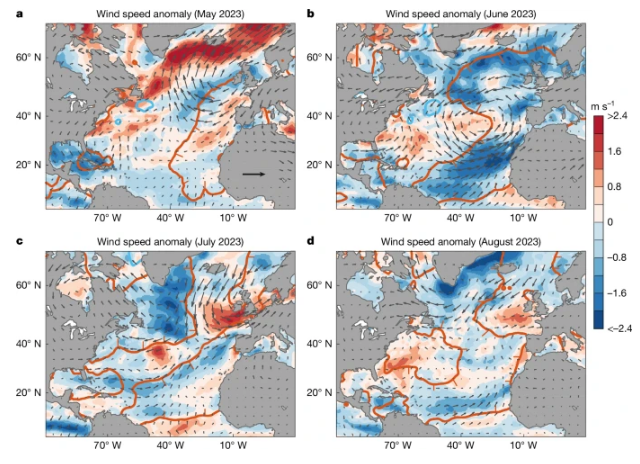
近日,澳大利亚新南威尔士大学Matthew H. England团队研究了2023年北大西洋海洋极端热浪的驱动因素。这一研究成果于2025年6月4日发表在《自然》杂志上。
北大西洋环流和温度模式在从天气到季节、十年、几十年及以后的所有时间尺度上深刻影响着全球和区域气候。2023年,北半球夏季出现了一场极端且接近盆地规模的海洋热浪,并在7月达到峰值。变暖几乎蔓延到北大西洋的所有地区,包括亚极地海洋,在过去的50-100年间,该地区呈降温趋势 。这些年与经向翻转环流的减缓有关。然而,导致这种异常表层海洋变暖的机制尚不清楚。
研究组使用观测约束的大气再分析以及海洋观测和模型模拟来表明,作用于极浅表面混合层的空气-海洋热通量,而不是异常的海洋热输送,是造成这一极端海洋变暖事件的原因。主要驱动因素被证明是异常微弱的风,导致混合层强烈变浅,导致北大西洋浅表层温度迅速升高。
此外,太阳辐射异常在与该地区一些主要航道大致对应的位置造成了区域尺度的变暖,这表明硫酸盐排放的减少也可能发挥了局部作用。随着近几十年来观察到混合层变浅的趋势,并预测这种趋势将持续到未来,北大西洋海洋热浪的严重程度将进一步恶化。
附:英文原文
Title: Drivers of the extreme North Atlantic marine heatwave during 2023
Author: England, Matthew H., Li, Zhi, Huguenin, Maurice F., Kiss, Andrew E., Sen Gupta, Alex, Holmes, Ryan M., Rahmstorf, Stefan
Issue&Volume: 2025-06-04
Abstract: North Atlantic Ocean circulation and temperature patterns profoundly influence global and regional climate across all timescales, from synoptic1 to seasonal2,3,4, decadal5, multidecadal6,7 and beyond8,9. During 2023, an extreme and near-basin-scale marine heatwave developed during Northern Hemisphere summer, peaking in July. The warming spread across virtually all regions of the North Atlantic, including the subpolar ocean, where a cooling trend over the past 50–100years has been linked to a slowdown in the meridional overturning circulation10,11. Yet the mechanisms that led to this exceptional surface ocean warming remain unclear. Here we use observationally constrained atmospheric reanalyses alongside ocean observations and model simulations to show that air–sea heat fluxes acting on an extremely shallow surface mixed layer, rather than anomalous ocean heat transport, were responsible for this extreme ocean warming event. The dominant driver is shown to be anomalously weak winds leading to strongly shoaling (shallowing) mixed layers, resulting in a rapid temperature increase in a shallow surface layer of the North Atlantic. Furthermore, solar radiation anomalies made regional-scale warming contributions in locations that approximately correspond to some of the region’s main shipping lanes, suggesting that reduced sulfate emissions could also have played a localized role. With a trend towards shallower mixed layers observed over recent decades, and projections that this will continue into the future, the severity of North Atlantic marine heatwaves is set to worsen.
DOI: 10.1038/s41586-025-08903-5
Source: https://www.nature.com/articles/s41586-025-08903-5
Nature:《自然》,创刊于1869年。隶属于施普林格·自然出版集团,最新IF:69.504
官方网址:http://www.nature.com/
投稿链接:http://www.nature.com/authors/submit_manuscript.html
